

KUOW Blog
News, factoids, and insights from KUOW's newsroom. And maybe some peeks behind the scenes. Check back daily for updates.
Have any leads or feedback for the KUOW Blog? Contact Dyer Oxley at dyer@kuow.org.
Stories
-
These Northwest snails might need stronger protection than just their tiny shells
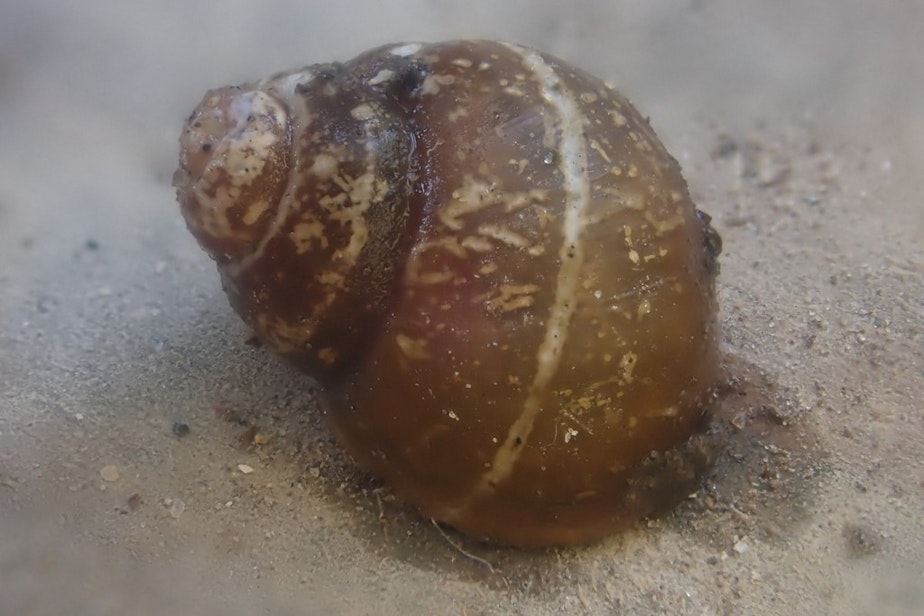 An ashy pebblesnail, one of two Columbia River basin snails proposed for endangered-species protection by advocates in April.Courtesy Tyson Ehlers/Center for Biological Diversity
An ashy pebblesnail, one of two Columbia River basin snails proposed for endangered-species protection by advocates in April.Courtesy Tyson Ehlers/Center for Biological DiversityEnvironmentalists are urging federal officials to save a pair of Northwest species that you’ve probably never heard of.
If you’ve seen one of them, you might have mistaken it for a pebble on the bottom of a clear-flowing creek.
While salmon get most of the attention, less-charismatic species lose out, too, when Northwest rivers are dammed or damaged.
Two tiny, freshwater snails that thrive in cold, clean, oxygen-rich water have been eliminated from most of the Columbia River Basin, according to the Center for Biological Diversity:
• The ashy pebblesnail. It has pale circles around its tentacled eyes.
• The shortface lanx. It looks like a tiny volcano with its cone-shaped shell.
These tiny snails, less than half an inch tall or wide, still cling to the bottom of a handful of rivers like the Methow in Washington and the Deschutes in Oregon.
The activist group has petitioned the U.S. Fish and Wildlife Service to protect these rare little mollusks.
RELATED: Looking back and looking ahead: the 50-year anniversary of the Endangered Species Act
The shortface lanx is sometimes called the giant Columbia River limpet, though it’s neither giant nor a limpet. It sits on its own branch of the evolutionary tree, being the only species in its genus.
The ashy pebblesnail has no lungs and requires the highly oxygenated environment of clear, cold, flowing water to breathe, as well as a stable, rocky bottom to cling to.
Continue reading » -
Auburn police officer’s murder trial tests new state law for police misconduct
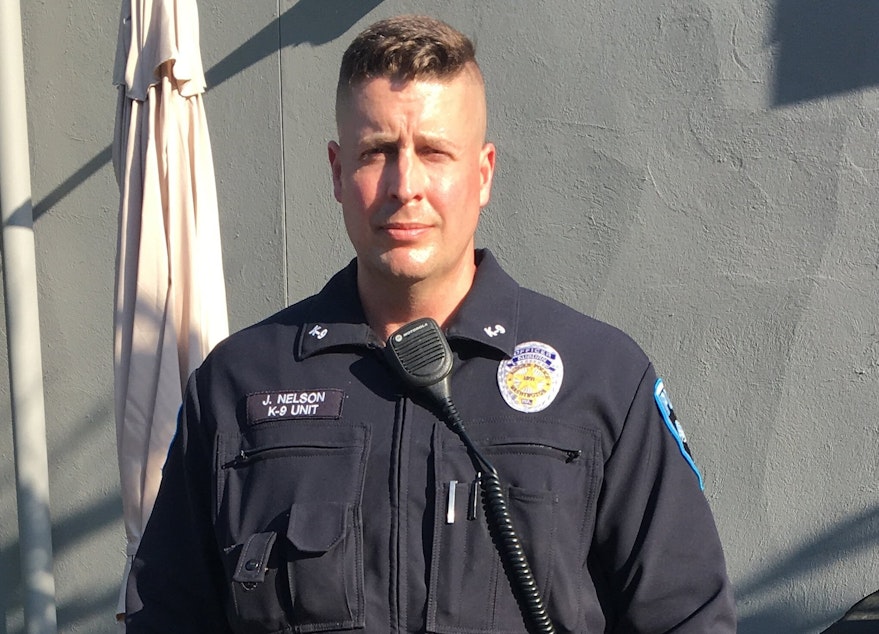 Officer Jeffrey Nelson was charged with murder in the second degree, and assault in the first degree, for the death of Jesse Sarey, age 26, in Auburn. Nelson is the first officer in Washington state to be charged under a new law that was passed by initiative, I-940.Auburn Police Department
Officer Jeffrey Nelson was charged with murder in the second degree, and assault in the first degree, for the death of Jesse Sarey, age 26, in Auburn. Nelson is the first officer in Washington state to be charged under a new law that was passed by initiative, I-940.Auburn Police DepartmentThe first police officer charged with murder in Washington under a new legal standard for police misconduct is heading to trial. Jury selection is scheduled to begin April 22 in the trial of Auburn police officer Jeffrey Nelson.
In August 2020, then-King County Prosecutor Dan Satterberg charged Nelson with second-degree murder and first-degree assault for killing 26-year-old Jesse Sarey. Nelson tackled and ultimately shot Sarey while trying to arrest him for disorderly conduct.
Sarey’s former foster mother Elaine Simons said it’s been a long wait to get to this trial date.
“Not only does the Sarey family need resolution but so does Officer Nelson,” she said. “Four years is a long time for everybody.”
RELATED: The silence is maddening: remembering Jesse Sarey
Simons said for her and supporters of the Sarey family, closure would be Nelson’s criminal conviction. Nelson said in his statement about the encounter that he believed Sarey was reaching for the officer’s handgun.
The trial is seen as an important test of Initiative 940, approved by voters in 2018 to remove what was seen as a barrier to prosecuting police for misuse of deadly force.
The law eliminated the requirement to prove “malice” on the part of police officers. Instead prosecutors must convince jurors that deadly force was not reasonable or necessary.
King County Superior Court Judge Nicole Gaines Phelps is hearing the case at the Maleng Regional Justice Center in Kent. It’s expected to last several weeks.
Judge Gaines has already determined that the trial testimony will exclude information about Officer Nelson’s tattoos, which could be read as endorsing police violence, and his previous deadly force encounters. The court has also excluded information about Sarey’s history of drug use and public intoxication.
RELATED: Police training commission moves to decertify Auburn cop charged with murder
Continue reading » -
Chaos and division erupt at Washington Republican convention in Spokane
 Washington State Republican Chairman Jim Walsh speaks to party delegates at the state GOP convention on April 19, 2024, during a raucous vote to allow consideration of gubernatorial candidate Semi Bird for the party's endorsement.Scott Greenstone
Washington State Republican Chairman Jim Walsh speaks to party delegates at the state GOP convention on April 19, 2024, during a raucous vote to allow consideration of gubernatorial candidate Semi Bird for the party's endorsement.Scott GreenstoneOn Friday, the Washington State Republican Party's convention in Spokane erupted with moments of booing, chanting obscenities, and people turning their backs to the party's own candidates.
Lorraine Blacklock, a precinct committee officer from King County, told the convention she'd never seen anything like this in her 30 years of involvement in the Republican Party.
"Civility has kind of disappeared," she said. "Even in our party, and that's sad."
RELATED: Republicans shrug off anti-LGBT comments from top Washington governor candidate
The convention drew delegates, precinct committee officers, and grassroots activists from across Washington for the weekend. The event is designed to develop the party's platform, choose the party's local leadership, and nominate candidates for statewide offices.
Continue reading » -
Seattle takes a cold plunge to help kids with 'butterfly-like' skin
 8-year-old Patterson McKenzie was diagnosed with epidermolysis bullosa when he was born in 2015.Courtesy of the McKenzie family
8-year-old Patterson McKenzie was diagnosed with epidermolysis bullosa when he was born in 2015.Courtesy of the McKenzie familyOn Sunday, a crowd of Seattleites will brave the cold waters of Alki Beach to increase awareness for the group of genetic skin conditions known as epidermolysis bullosa, which cause painful blistering and tearing. The plunge was organized by the nonprofit EB Research Partnership, which aims to raise $80,000 for research that could help cure and improve treatment for the disorders.
8-year-old Patterson McKenzie was diagnosed with epidermolysis bullosa when he was born in 2015. He said taking a cold plunge and having his condition are both pretty painful, and offered some pointers.
“I breathe heavily in through my mouth a little bit before,” he said.
Annie McKenzie, Patterson's mom, added that they also use distraction methods like singing songs that help guide him and other cold-plungers through the shock. Both of them will be at the beach this weekend, with a playlist featuring Willie Nelson, Pearl Jam, and Marvin Gaye, cheering people on.
“The reason we plunge is to be uncomfortable for a minute, to be in solidarity with kids who have EB who are in pain from birth,” said Jill Vedder, chairwoman of EB Research Partnership, in an organizational meeting earlier this year. “So duck poop is nothing.”
Jill Vedder, along with her husband and Pearl Jam frontman Eddie Vedder, founded the organization in 2010.
The annual cold plunge was started in Massachusetts in 2018 by Emily Kubik and her friends and family, two years after her daughter Elodie was diagnosed with a form of epidermolysis bullosa.
“In some of the dark days in the beginning, which I know so many families have gone through, we were struggling to just keep our heads above water trying to understand what we were dealing with,” Kubik said earlier this year.
They wanted to raise awareness and show Elodie that people cared about her with this plunge, Kubik added. There’s also a fundraising component to the tradition.
“I don’t think in that first year we thought we would raise maybe $30,000, honestly,” Kubik said. “So the fact that just a few years later we’ve raised just over $2 million is really incredible.”
Continue reading » -
Angry birds: Hummingbirds are cute, but they’re primed to fight
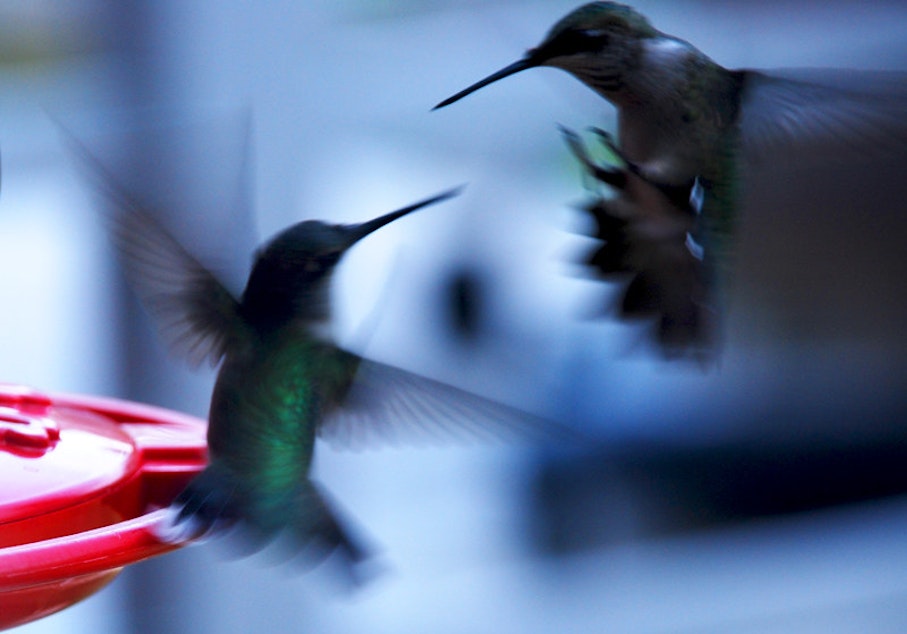 Two hummingbirds, not willing to share space at a feeder. Hummingbirds often fight or chase each other away in competition for food and territory.
Two hummingbirds, not willing to share space at a feeder. Hummingbirds often fight or chase each other away in competition for food and territory.At first, I didn't know what I was seeing — a tiny blur at the edge of a bush in Seattle's Wedgwood neighborhood, from which emitted a dramatic, high-pitched scream.
Then the scene became clear: Two hummingbirds were brawling, violently, think barroom at 1 a.m. And one was clearly losing.
Hummingbirds, I realized, are not just adorable. They're also jerks.
Yes, jerks. But don't take my word for it.
“'Hummingbirds are jerks' is a pretty good tagline for how hummingbirds operate. I use that word a lot to describe them. They fight all the time," said Alyssa Sargent, a PhD candidate at the University of Washington working in the behavioral ecophysics lab.
RELATED: UW researcher slows down hummingbirds to study them. What he found is amazing
I witnessed the ultimate victor bashing its foe into the ground as it held on with its feet, stabbing its competitor with its needle-like beak the entire time.
It was a sobering moment. Should I have broken up the fight? Perhaps offered each bird complimentary nectar and let them chirp out their woes until they calmed down?
"Trying to break up a hummingbird fight, you’d be fighting a losing battle there," Sargent said.
Sure, hummingbirds are renowned for their beauty and rapid, graceful flight. They are a treat in any garden and are generally greeted with joy.
Continue reading » -
City could tear down dangerous vacant buildings under Seattle Mayor Harrell's emergency proposal
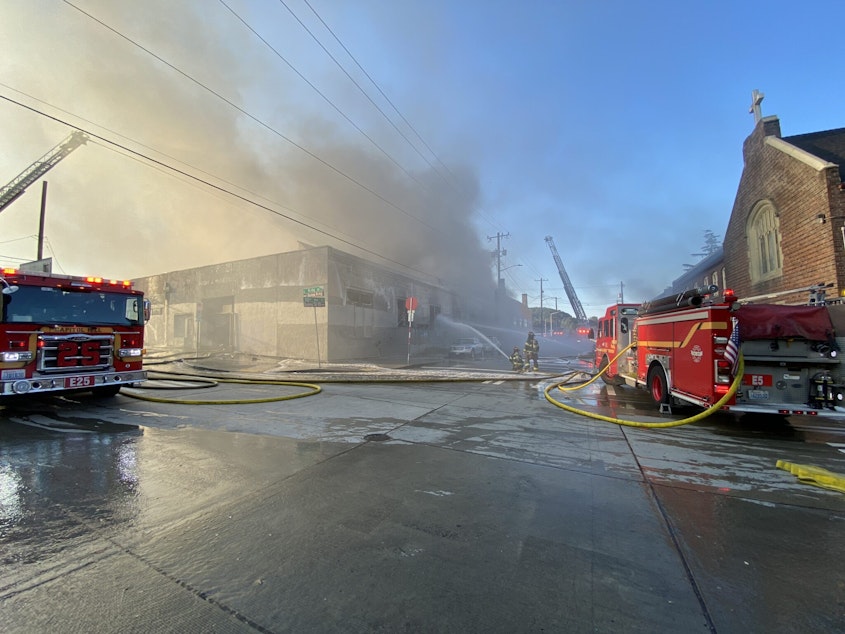 Seattle fire crews respond to a two-alarm fire at a vacant warehouse in the 1000 block of South King Street on July 20, 2023.
Seattle fire crews respond to a two-alarm fire at a vacant warehouse in the 1000 block of South King Street on July 20, 2023.The city of Seattle would be allowed to demolish unsafe vacant buildings to prevent them from catching fire under emergency legislation proposed by Mayor Bruce Harrell.
There were 130 vacant building fires reported in Seattle last year, three of them deadly. There have been 30 more such fires so far this year.
RELATED: E-bike fires are sparking trouble in Seattle. Here's how to use them safely
“While the city has taken steps to encourage adaptive reuse of vacant structures for new purposes, we cannot allow these unmaintained structures to put lives and property at risk from trespassers, arson, and other crimes,” Harrell said.
If owners of dangerous buildings don’t secure or demolish them when ordered to do so by the fire department, the city could take those steps itself and put a lien on the property for reimbursement under the proposed law change.
“This legislation will give the Seattle Fire Department a new tool to take quick action to remedy derelict buildings that threaten the health and safety of our neighborhoods,” Harrell said.
The Seattle Fire Department is already tracking more than 40 vacant buildings that could be affected by the proposed law, and estimates it could take action on about 10 buildings a year.
On New Year’s Day, a three-alarm fire in a First Hill vacant building forced the evacuation of a neighboring apartment building. There had also been a three-alarm fire in the same building in 2022.
Fire officials say one factor contributing to the city’s 69% increase in derelict buildings catching fire between 2013 and 2021 is the growing number of homeless people who use the buildings for shelter. Fires lit to keep warm — or to smoke fentanyl and meth — can spread.
RELATED: Investigators sound alarm over string of Seattle fires and
Continue reading » -
Here's why car insurance just jumped nearly 25% in Washington state

If you have a car insurance policy in Washington state, you may have noticed that it's gotten much more expensive this year.
In a recent article in The Seattle Times, reporter Victor Whitman shared the stories of Washington drivers who saw their insurance premiums jumping hundreds of dollars. This comes after the state's insurance commissioner approved a bigger than usual increase to average auto premiums in Washington, nearly 25%.
RELATED: Both hands on the wheel, Washington drivers. Your insurance rates are about to jump 24%
So what's going on with auto insurance? Why are we on this rocket ship?
To find out, Soundside sat down with Kenton Brice, the president of the Northwest Insurance Council, a trade group funded by insurers.
While there are many reasons why insurance premiums have risen so dramatically, the simplest answer is that it's just much more expensive to fix vehicles today.
"It used to be that if you got in a fender bender in a parking lot, replacing the bumper of your vehicle might cost $1,500," Brice said. "That same bumper today has sensors and cameras and so forth in it and can cost thousands of dollars to replace."
So, while there's no question that the complexity and technological advances of modern cars have made driving safer, they're also much more expensive to fix.
Another big factor is the number of people on the roads. That plus the feeling of safety in a tech-heavy modern vehicle means that people are getting into increasingly worse wrecks.
"So cars are safer, they have a lot more technology that helps prevent injuries. But people are maybe taking advantage of those or don't know how those safety features work," Brice explained. "So they're driving faster, they're driving angrier, and the crashes that they're getting into are more severe."
You can listen to the entire conversation with NW Insurance Council president Kenton Brice by clicking the play button above.
Continue reading » -
More aboard! Activists, officials disagree about how to boost Amtrak Cascades ridership
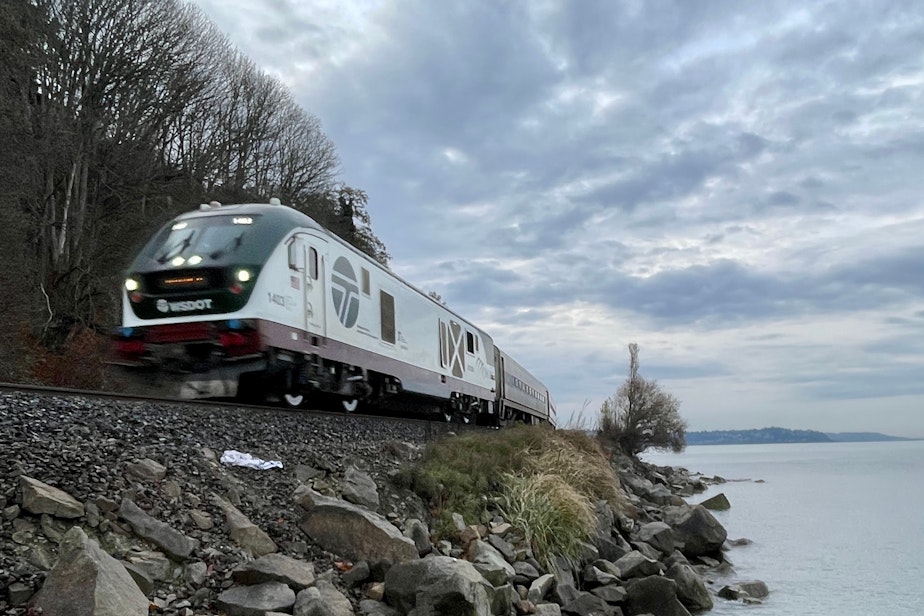 The Amtrak Cascades heads north in Shoreline, Washington, on Nov. 30, 2023.KUOW Photo/John Ryan
The Amtrak Cascades heads north in Shoreline, Washington, on Nov. 30, 2023.KUOW Photo/John RyanOfficials and climate activists disagree about the best way to get more people on board passenger trains between Oregon and Canada.
Ridership on the Amtrak Cascades, running between Eugene, Oregon, and Vancouver, British Columbia, has not returned to pre-pandemic levels, though it came close in 2023.
The line served 746,000 passengers in 2023, nearly doubling its 2022 ridership and reaching 90% of the Cascades’ pre-pandemic peak of 824,000 in 2019, according to the Washington State Department of Transportation.
The transportation department, which pays Amtrak to operate the Cascades line, has been asking the public how to improve service over the next 20 years.
RELATED: Dude, where’s my train? Why freight makes Amtrak late
The feedback has emphasized faster, greener, more frequent, and more reliable trains, as well as better connections to other modes of travel at train stations.
Major employers contacted by rail officials called for faster travel times and better Wi-Fi on the Cascades line.
Retired scientist and climate activist Arvia Morris with the Climate Rail Alliance says planners aren’t taking Amtrak’s need for speed seriously.
“We do 53 miles an hour today, and in their current plan, in 20 whole years, they would get us to 58 miles an hour,” Morris said. “We just don't think that plan is good enough.”
Continue reading » -
Could a return of workers to downtown offices rescue Seattle’s ailing budget?
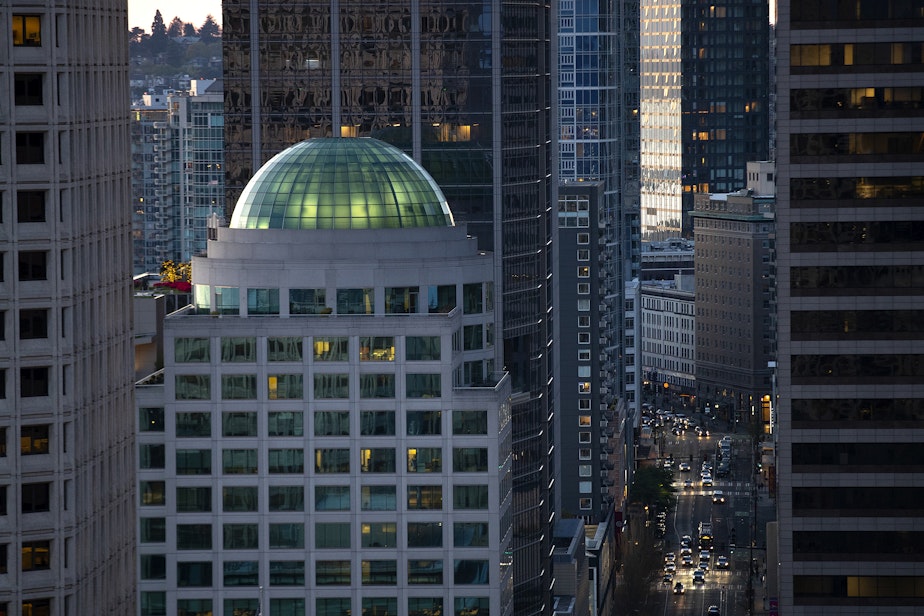 A view of downtown Seattle is shown from the Smith Tower Observatory as the sun sets on Friday, April 12, 2024.KUOW Photo/Megan Farmer
A view of downtown Seattle is shown from the Smith Tower Observatory as the sun sets on Friday, April 12, 2024.KUOW Photo/Megan FarmerWith Seattle facing a projected $241 million budget shortfall in 2025, the City Council is looking at how Seattle got into this hole and how it might climb its way out.
A combination of record inflation and a sharp revenue drop during the height of the pandemic put the city in a financial bind, analysts told the City Council Wednesday.
Aly Pennucci, Council central staff deputy director, said that while the economic forecast looks decent in Seattle, it costs a lot more than it did five years ago to make payroll.
“The number of employees in the city hasn't increased significantly in this period, but the cost of paying for employees has increased," Pennucci said.
Much of the growth in general fund spending aside from inflation was aimed at human services, analysts said, like addressing the homelessness crisis.
Jan Duras, who leads the Office of Economic and Revenue Forecasts, told the council one thing that could help fill city coffers is more suburban workers coming back to their Seattle offices.
“The amount of tax base depends on where the economic activity takes place. So a worker that's coming to the office performing work here, rather than performing the work at home in Medina, makes a significant difference for the [business and occupancy tax] and for the payroll expense tax," Duras said.
More workers commuting into the city would also boost Seattle sales tax revenues, which took a surprise dive late last year.
Other strategies could include an early retirement program for city workers, cutting programs, combining departments, and loosening restrictions on how certain funds are spent, like revenue from the city’s sweetened beverage tax.
Correction 1:31 pm 4/19/24 - An earlier version of this story misattributed a quote by Aly Pennucci.
Continue reading » -
2023 was 'the worst year' for Anti-Jewish hate in the Northwest, Anti-Defamation League reports
 A stained glass rendering of the Ten Commandments at Sephardic synagogue, Ezra Bessaroth in Seward Park. The synagogue was established by migrants from the island of Rhodes.KUOW Photo/Anna Boiko-Weyrauch
A stained glass rendering of the Ten Commandments at Sephardic synagogue, Ezra Bessaroth in Seward Park. The synagogue was established by migrants from the island of Rhodes.KUOW Photo/Anna Boiko-WeyrauchOn Tuesday, the Anti-Defamation League of the Pacific Northwest released the results of its annual report, detailing a sharp increase in anti-Jewish harassment and vandalism. And the numbers were growing even before the Israel-Gaza War began in October.
“Unfortunately, what we saw was that 2023 was the worst year for antisemitic incidents, building on the dramatic year-over-year increases that we have already been seeing over the past couple of years,” said Miri Cypers, regional director of the Anti-Defamation League of the Pacific Northwest.
The group has published an annual audit of anti-Jewish incidents with the mission of stopping antisemitic hate since 1979.
RELATED: Washington state sees rise in anti-Arab, anti-Jewish hate incidents amid Israel-Hamas War
The numbers from last year, which show a 192% increase in anti-Jewish incidents in Washington state since 2022, also illustrate an increase in vandalism and harassment in Alaska, Idaho, Montana, and Oregon there were a total of 307 anti-Jewish incidents across the Northwest last year, up from 130 in 2022, according to the report. Washington state saw 190 total anti-Jewish incidents, including 31 acts of vandalism, one assault, and 158 reports of harassment last year.
The FBI says it’s also continuing to monitor anti-Jewish incidents and hate crimes in Washington, and also noted a rise. Though the numbers have been growing each year, FBI Special Agent Ryan Bruin said, there’s been an uptick in anti-Jewish incidents since the Israel-Gaza War began on Oct. 7.
“We've seen a marked increase in hoax bombs and active shooter threats targeting synagogues and Jewish Community Centers both in Washington state and nationwide,” Bruin said.
RELATED: After receiving racist hate mail, UW students call for action
Continue reading » -
Snoqualmie community steps up to help 4 women-owned businesses destroyed in fire
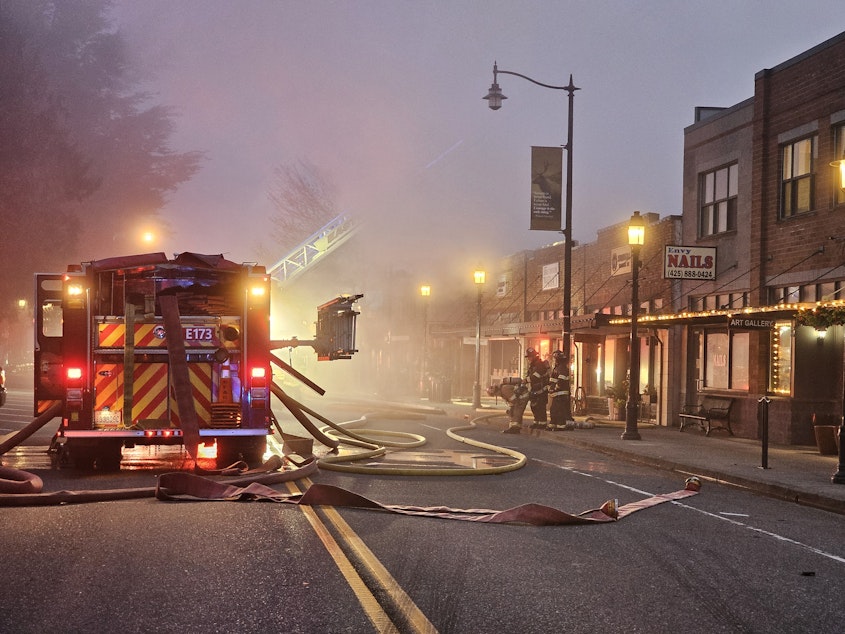 Early morning photo of 2024 large fire of building in Historic Snoqualmie DowntownJulie Chung
Early morning photo of 2024 large fire of building in Historic Snoqualmie DowntownJulie ChungA large fire destroyed four women-run businesses in a Historic Snoqualmie retail building early Sunday morning. Now the city is rallying around the business owners to help them rebuild.
Snoqualmie Ice Cream owners Heather Dean and Julie Chung are still processing the news that a fire destroyed part of the building that houses their business.
“As we go into our busy season it's a really devastating loss for us as small business owners. It's a lot,” Chung said.
RELATED: Canoeing to work: Floods bring chaos, renewal to Snoqualmie Valley
The fire was discovered during a routine patrol of the area by a Snoqualmie Police officer. The City of Snoqualmie said the most significant fire damage occurred on the back side of the building. That’s where Chickadee Bakeshop, Snoqualmie Pie Co., and Littlest Wishes Photography were located.
The SnoValley Chamber of Commerce is running a GoFundMe campaign to help raise money for the businesses impacted by the fire. So far, the campaign has exceeded its $50,000 goal by several thousand dollars.
No injuries were reported and Dean said she is thankful. “Five fire agencies responded to us, and it is a dry, 100-year-old business district. They saved the downtown,” she said.
RELATED: This story begins with a cougar eating a tiny dog in Snoqualmie
Though flames did not reach their shop, Chung and Dean lost all of their inventory and equipment.
“The smoke damage is incredible,” Chung said. “There is no way that we can operate. We're kind of thinking that it needs to be a whole remodel down to the studs, and that's going to take time.”
Chung said they are trying to find new employment opportunities for 16 employees who work at the Snoqualmie location.
RELATED: Snakes on an overpass: I-90 installs wildlife crossing near Snoqualmie
Continue reading » -
Drought emergency declared for Washington state ahead of warm summer
A drought emergency was declared for the state of Washington Tuesday, as state officials face low water supply ahead of an expected warmer-than-normal summer across the region. Seattle, Tacoma, and Everett are excluded from the emergency declaration.
"We depend on that winter snowpack to meet the needs of Washington’s farmers, fish, and communities during the dry summer months. And this year, it’s just not at the level we’re accustomed to and rely on," Gov. Jay Inslee said in a statement.
RELATED: As the Northwest spring arrives, so do anxieties over water for farming, and summer wildfires
The Washington State Department of Ecology declared the drought emergency April 16, 2024. The department makes such a declaration when the state's water supply is less than 75% of normal. Current statewide snowpack is at 68% of normal; however, regions like the Olympic Mountains are much lower. This means that streams are running lower and warmer. For example, the Dept. of Ecology points to the Chelan River where streamflow is at 52% of normal.
Caroline Mellor, statewide drought lead with the Department of Ecology, noted that Everett, Seattle, and Tacoma have strong water management strategies that make them more resilient to the drought. That is why these areas have been excluded from the emergency declaration.
"For Everett, and Seattle, and Tacoma, on those utilities that have large reservoirs, that allows them to more actively manage their water supplies," said "And they have been able to manage their supplies looking at conditions coming into the spring and summer ... and so they do not currently, nor anticipate facing any hardship for their water supplies. That's specifically for those three utilities."
By making the declaration, $4.5 million in drought-response grants will be opened up to public agencies to help mitigate complications from low water supplies. It also allows Ecology to handle emergency water right permits.
Washington state emergency drought declaration 2024
The current situation in Washington state has been long in the making. The department notes that Tuesday's declaration is "really a continuation of 2023’s drought emergency." That declaration was slated to end in June of this year; however, the recent El Niño weather pattern meant that enough rain did not fall to make up for 2023's loss.
Last winter was relatively dry. This came after Seattle was asked to conserve water in the fall due to low supply. The Seattle area then recorded its warmest December on record. Projections for summer 2024 indicate warmer than normal temperatures.
“What that actually means, in practice, is that we are facing what's called a ‘snowpack drought'," Mellor said. "A snowpack drought is different than just a regular rain or precipitation drought, because this means that most of our precipitation has come as rain instead of snow, or that snow has melted much earlier than it would in a normal year; we would expect the snow melt to happen gradually throughout spring and summer from the mountains”
“The Olympic basin is at 61% of normal for snowpack,” she said. “And North Puget Sound, that includes the North Cascades, is at 57% of normal … Lower Yakima, for that basin, they’re at 46% of snowpack. That's really concerning, because that means that water that's held in that snowpack either has already melted out to the ocean, or will be melting out a lot earlier. We are already seeing lower-than-normal streamflow conditions, as well as a clear forecast for continued or worsening streamflow conditions for April to September."
Mellor said people can expect to see streams drying up sooner than expected, especially in August. This will affect irrigation and recreational fishing.
Ecology said that many watersheds are already projecting low water supplies over the coming warm months. For example, water systems in Clallam County and Whatcom County are now trucking in water to meet demand. Mellor said Ecology anticipates that water may need to be trucked into the Olympic Peninsula this summer.
“There are clear impacts that we expect for water users and the environment across the state," Mellor said. "Specifically for agriculture, there are a number of impacts expected for irrigators and other agricultural sectors, as well as for domestic drinking water supplies, particularly for rural areas on smaller drinking water systems.”
Mellor said that drought declarations have increased over the past 10 years, since the "historically warm and dry drought of 2015." Washington has declared drought in six of the last 10 years.
"I will say, while these conditions are not as bad as 2015, we are already seeing these conditions in April. And with forecasts for warmer temperatures way above normal, and somewhat below normal precipitation, we have no expectation that these conditions will improve. We expect that they'll either stay the same or get worse in terms of drought conditions across the state."
Looking ahead, Mellor recommends that Washingtonians consider drought-tolerant plants for gardening, and using low-water-use gardening practices, like a hose timer. Also, only run dishwashers when they are full.
Continue reading »
